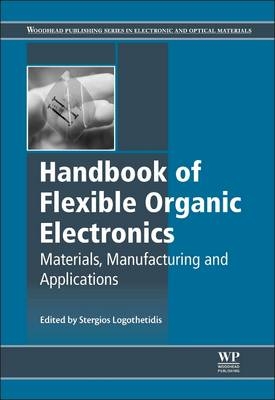
Handbook of Flexible Organic Electronics
Woodhead Publishing Ltd (Verlag)
978-1-78242-035-4 (ISBN)
- Keine Verlagsinformationen verfügbar
- Artikel merken
Professor Stergios Logothetidis works in the Laboratory for Thin Films, Nanosystems and Nanometrology at the Department of Physics, Aristotle University of Thessaloniki in Greece.
Related titles
List of contributors
Woodhead Publishing Series in Electronic and Optical Materials
Part One. Properties and materials
1. Mechanics of curvature and strain in flexible organic electronic devices
1.1. Introduction
1.2. Stress and strain analyses
1.3. Failure under tensile stress
1.4. Failure under compressive stress
1.5. Mechanical test methods
1.6. Toward compliant and stretchable electronics
1.7. Conclusions
2. Structural and electronic properties of fullerene-based organic materials: density functional theory-based calculations
2.1. Introduction
2.2. Theoretical background
2.3. Structural transformations of fullerenes based on DFT calculations
2.4. Prototype impurities in fullerene crystals and electronic effects
2.5. Summary and future trends
3. Hybrid and nanocomposite materials for flexible organic electronics applications
3.1. Introduction
3.2. Production methods
3.3. Properties
3.4. Limitations
3.5. Electronics applications
3.6. Future trends
3.7. Sources of further information and advice
4. Organic polymeric semiconductor materials for applications in photovoltaic cells
4.1. Introduction
4.2. Polymeric electron donors for bulk-heterojunction photovoltaic solar cells
4.3. Fullerene and polymeric-based electron acceptors for bulk heterojunction photovoltaic solar cells
4.4. Hybrid structures of polymer, copolymer semiconductors with carbon nanostructures
4.5. Conclusions
Part Two. Technologies
5. High-barrier films for flexible organic electronic devices
5.1. Introduction
5.2. Encapsulation of flexible OEs
5.3. Permeability mechanisms through barrier materials
5.4. Permeation measurement techniques
5.5. Advances in high-barrier materials
5.6. Conclusions
6. Advanced interconnection technologies for flexible organic electronic systems
6.1. Introduction
6.2. Materials and processes
6.3. Reliability
6.4. Summary and future trends
7. Roll-to-roll printing and coating techniques for manufacturing large-area flexible organic electronics
7.1. Introduction
7.2. Printing techniques
7.3. Coating techniques
7.4. Specialist coating techniques
7.5. Encapsulation techniques
7.6. Applications
7.7. Future trends
8. Integrated printing for 2D/3D flexible organic electronic devices
8.1. Introduction
8.2. Fundamentals of inkjet printing
8.3. Electronic inks
8.4. Vertically integrated inkjet-printed electronic passive components
8.5. Conclusions
9. In situ characterization of organic electronic materials using X-ray techniques
9.1. Introduction
9.2. Grazing incidence X-ray diffraction
9.3. Temperature-dependent studies
9.4. In situ X-ray studies
9.5. Conclusions
10. In-line monitoring and quality control of flexible organic electronic materials
10.1. Introduction
10.2. Fundamentals of spectroscopic ellipsometry
10.3. Characterization of organic electronic nanomaterials
10.4. Conclusions and future trends
11. Optimization of active nanomaterials and transparent electrodes using printing and vacuum processes
11.1. Introduction
11.2. Optimization of r2r printed active nanomaterials and electrodes
11.3. Combination of wet and vacuum techniques for OEs
11.4. Future trends
12. Laser processing of flexible organic electronic materials
12.1. Introduction
12.2. The physics of laser interaction with thin films
12.3. Laser systems and sources
12.4. Beam delivery assembly
12.5. Laser modification of materials and C surfaces
12.6. Laser ablation processes
12.7. Laser printing
12.8. Conclusions and future trends
13. Flexible organic electronic devices on metal foil substrates for lighting, photovoltaic, and other applications
13.1. Introduction
13.2. Substrate selection
13.3. Substrate preparation
13.4. TFTs for displays on metal foil
13.5. OLED lighting and photovoltaics on metal foil
13.6. Future trends
Part Three. Applications
14. Smart integrated systems and circuits using flexible organic electronics: automotive applications
14.1. Introduction
14.2. Materials for integrated systems
14.3. Manufacturing processes
14.4. Automotive applications
14.5. Conclusions
15. Chemical sensors using organic thin-film transistors (OTFTs)
15.1. Introduction
15.2. Gas and vapour sensors
15.3. Humidity sensors
15.4. pH detection
15.5. Glucose detection
15.6. Deoxyribonucleic acid detection
15.7. Conclusions
16. Microfluidic devices using flexible organic electronic materials
16.1. Introduction
16.2. Microfluidics and electronics
16.3. Materials and fabrication techniques
16.4. Device examples
16.5. Summary
16.6. Future trends
17. Two-terminal organic nonvolatile memory (ONVM) devices
17.1. Introduction
17.2. Carbon nanotube (CNT)-based 2T-ONVM structures
17.3. Conclusion
18. Printed, flexible thin-film-batteries and other power storage devices
18.1. Introduction
18.2. The development of printed batteries
18.3. Basic design of printed batteries
18.4. Printing technologies and challenges
18.5. Properties of printed batteries
18.6. Conclusions and future trends
Appendix: Patent applications on printed batteries
Index
Colour section plate captions
| Erscheint lt. Verlag | 8.12.2014 |
|---|---|
| Reihe/Serie | Woodhead Publishing Series in Electronic and Optical Materials |
| Verlagsort | Cambridge |
| Sprache | englisch |
| Maße | 152 x 229 mm |
| Gewicht | 810 g |
| Themenwelt | Technik ► Elektrotechnik / Energietechnik |
| ISBN-10 | 1-78242-035-5 / 1782420355 |
| ISBN-13 | 978-1-78242-035-4 / 9781782420354 |
| Zustand | Neuware |
| Haben Sie eine Frage zum Produkt? |
aus dem Bereich


